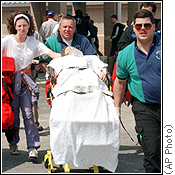 most are. But it is usually violence in more socially accepted
forms of bullying - intimidation, taunting, sarcasm and ridicule.
most are. But it is usually violence in more socially accepted
forms of bullying - intimidation, taunting, sarcasm and ridicule.Over half of school age children
admit to having been bullied at one time or another. The Jonesboro masacre has been
attributed to a bully with a rifle. We are astonished to find
violence in our public schools of this degree, but I remember
my own school to be very violent as well. As I suppose most are. But it is usually violence in more socially accepted
forms of bullying - intimidation, taunting, sarcasm and ridicule.
most are. But it is usually violence in more socially accepted
forms of bullying - intimidation, taunting, sarcasm and ridicule.
Researchers have finally given up their notion of "the poor bully", having assumed from the beginning that bullies must be exhibiting their own poor self-esteem. This is hiding the obvious. Bullies enrich their esteem - their pride in themselves - by depriving the same from their cohorts. An effort in Norway to deal with the issue revealed that 80% of students who were targets of bullies exhibited "insecurity, feelings of being worthless and that they would probably not fight back."
The "mature" response offered by cohorts and instructors was to fight back, "Don't let him pick on you." And so the blame is placed on the victim. But bullying is really a form of collective power. The bully abuses his victim publicly, before his peers, and enjoys a show of strength, while the victim draws additional scorn and ridicule. It is a social theatre, not a personal one. Any treatment that aims at the individual, therefore, will miss it entirely. It is from the social group that the individual draws feelings of insecurity and worthlessness. This, in turn, draws additional abuse. And so it goes.
Some children enjoy fighting. It is a normative value. Violence and intimidation are the means to exhibit and solidify power in a social setting. Bullying is not always directed at stronger to weaker - girls can bully as much as boys - but is more a question of perceived social values. Bullies perceive violence as more respectable than do their victims, who may value other social or moral norms. But within the context of the social setting, the bully is usually right.
The big tough guy model is, of course, all over the place. It is in most movies, most video arcades, most prisons. Ghandi, Mandella, the Dalai Lama, and others who exemplify nonviolence and compassion are unknown to most children. If they were, the victims of bully-abuse would not have to feel such loss of esteem, worthless or defeated.
Bullies control this world because we give them respect. Victims are such because they lose their own. It is just this simple. We do not have to respect bullies; we do not have to blame victims. They are behaviors - a social relation. We should respect those who respect others; elicit encouragement, not criticism; provide help, and not harm. Why don't we teach this in our schools?
Links
International Coalition For Acceptance and Tolerance (ICAT)
Violence and Discipline Problems in U.S. Public Schools: 1996-97